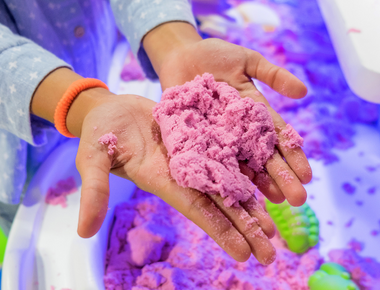3 Things Every Child Therapist Needs to Know About a Kid’s Nervous System
Proven body-based interventions that’ll help your young clients thrive
∞≈¿÷ ”∆µ Team

Have you ever worked with a child or teen who felt unreachable? That even with countless books, worksheets, resources, and interventions… none of it was adequate to help you address their unique case of complex trauma?
These clients are often hurting themselves, aggressive, shutting everyone out, and trapped in the hopeless belief that things will never change. But with an understanding of Polyvagal Theory combined with the power of play therapy, you can be the therapist who helps them return to a place of safety and connection!
Jackie Flynn, ED.S., MA, LMHC-S, RPT provides insight into proven body-based interventions that’ll help your young clients thrive in any setting – during session, in the classroom, or at home.
What are the cues of safety and danger in their bodies? Are there things (medical or physiological) that we need to know? Similarly, you’ll want to think about what their relationships with others entail and the cues of safety and danger regarding those relationships.
Many of the kids you work with go to school, come back home, and are most likely involved in extracurricular activities. You’ll want to look into the cues of safety and danger in those environments.
It’s also important to think about behavior in a different way. Remember - what’s underlying in the nervous system and behavior is an adaptation of what’s going on in the outside world and is influenced by the child’s cues of safety.
When you focus on this technique and develop an environment that helps remove the cues of threat, it can make a huge difference in creating safety and connecting with your young clients - and we can do that through play, too. Play has a beautiful way of allowing us to be in two states of our nervous system at the same time. It allows us to put ourselves in a state of vulnerability and trust, which helps foster trust with your client.
Another way to promote safety and connection is through familiarity and predictability. When a child knows what’s coming up or has an idea of what to expect, it builds safety. You can elevate a sense of safety and connection by scheduling the child’s appointments around the same day or time every week to establish a routine for the child.
When you’ve done everything you can and the child still has emotional pain (especially when working with traumatized clients), you can’t rely fully on words. This is when you’ll need to create as many cues of safety and remove as many cues of threats as possible. If possible, you can use the Polyvagal Theory inspired body scans:
These clients are often hurting themselves, aggressive, shutting everyone out, and trapped in the hopeless belief that things will never change. But with an understanding of Polyvagal Theory combined with the power of play therapy, you can be the therapist who helps them return to a place of safety and connection!
Jackie Flynn, ED.S., MA, LMHC-S, RPT provides insight into proven body-based interventions that’ll help your young clients thrive in any setting – during session, in the classroom, or at home.
1. Get curious about child’s safety in 3 ways: body, relationships and environmentGet curious about the child’s safety in 3 ways: body, relationships and environment
What are the cues of safety and danger in their bodies? Are there things (medical or physiological) that we need to know? Similarly, you’ll want to think about what their relationships with others entail and the cues of safety and danger regarding those relationships.
Many of the kids you work with go to school, come back home, and are most likely involved in extracurricular activities. You’ll want to look into the cues of safety and danger in those environments.
It’s also important to think about behavior in a different way. Remember - what’s underlying in the nervous system and behavior is an adaptation of what’s going on in the outside world and is influenced by the child’s cues of safety.
2. Focus on safety and connection
When you focus on this technique and develop an environment that helps remove the cues of threat, it can make a huge difference in creating safety and connecting with your young clients - and we can do that through play, too. Play has a beautiful way of allowing us to be in two states of our nervous system at the same time. It allows us to put ourselves in a state of vulnerability and trust, which helps foster trust with your client.
Another way to promote safety and connection is through familiarity and predictability. When a child knows what’s coming up or has an idea of what to expect, it builds safety. You can elevate a sense of safety and connection by scheduling the child’s appointments around the same day or time every week to establish a routine for the child.
3. Know the 3 states of the autonomic system
When you’ve done everything you can and the child still has emotional pain (especially when working with traumatized clients), you can’t rely fully on words. This is when you’ll need to create as many cues of safety and remove as many cues of threats as possible. If possible, you can use the Polyvagal Theory inspired body scans:
- Ventral Vagal (Green state)
- Sympathetic (red state)
- Dorsal Vagal (dark state/shutdown)
Connect with Young Clients Through Play Therapy

Between hyper-busy schedules, an overemphasis on achievement and saying yes to everything, there is no time for play, curiosity or imagination. And without play, we risk derailing healthy child development. These stressors of kids' daily lives are only exacerbated by the pandemic, racism, sexual ambiguity, bullying and social media.
Kids struggle to navigate relationships, learn how to flexibly problem-solve, facilitate adaptive coping skills, resolve conflict, tolerate stress and regulate emotions.
That's why we've created this state-of-the-art play therapy training to get evidence-based interventions your kids need now. You'll learn to utilize the POWER OF PLAY with kids of all ages from leading child experts including Dan Siegel, Liana Lowenstein, Ana Gomez, David Crenshaw, Jessica Stone and many more.
Whether you’re a seasoned therapist or new to the field, you’ll get kid-tested, proven tools to help young clients thrive.
Kids struggle to navigate relationships, learn how to flexibly problem-solve, facilitate adaptive coping skills, resolve conflict, tolerate stress and regulate emotions.
That's why we've created this state-of-the-art play therapy training to get evidence-based interventions your kids need now. You'll learn to utilize the POWER OF PLAY with kids of all ages from leading child experts including Dan Siegel, Liana Lowenstein, Ana Gomez, David Crenshaw, Jessica Stone and many more.
Whether you’re a seasoned therapist or new to the field, you’ll get kid-tested, proven tools to help young clients thrive.
Topic: Children and Adolescent Behavioral
Tags: Advice | Body | Children | Mindfulness | Therapy Tools



